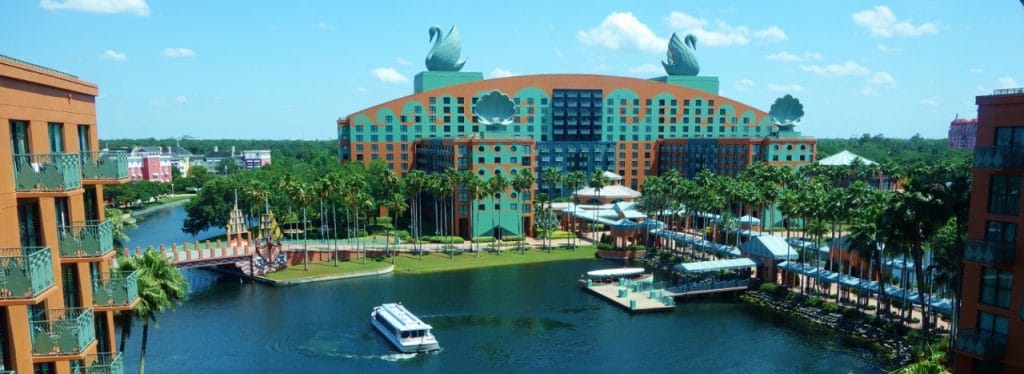A Friday Visit with Jim Korkis: The Swans and Dolphins of the Swan and Dolphin
By Dave Shute
Welcome back to Fridays with Jim Korkis! Jim, the dean of Disney historians and author of Jim’s Gems in The easy Guide, writes about Walt Disney World history every Friday on yourfirstvisit.net.
THE SWANS AND DOLPHINS OF THE SWAN AND DOLPHIN
CEO Michael Eisner felt that the two legacies he would leave at Disney were an improvement in culinary offerings and the development of what he termed “entertainment architecture” that referred to telling stories architecturally in buildings on Disney property that were not in the theme parks.
Eisner brought in renowned architect Michael Graves to design the Team Disney corporate building in Burbank, California. Graves said when he was in meetings with Michael Eisner, Eisner told him: “Look, everyone here will have some design priorities for you, but I only have one priority. When I come in to work each morning and go up to my office, I’ll probably have very little to smile about. So do something that will make me smile when I arrive.”
When his first designs for the Team Disney building were rejected, Graves came up with the concept of having the Seven Dwarfs as caryatids. A caryatid is a sculpted figure serving as an architectural support, taking the place of a column or a pillar supporting horizontal bands. “Because Snow White and the Seven Dwarfs was truly the foundation of the Disney Studios and supported the growth of the company, just as the dwarfs are supporting the building,” claimed Graves.
Eisner was so pleased with the final result that he had Graves come up with designs for the Swan and Dolphin resorts.
Designed by Graves, the swan statues (like the dolphin statues) were created from steel, wood and fiberglass, and were believed to be the largest structures of their kind in the world at the time. Since there were no existing samples to work from, Disney artist Gary Graham, following Graves’ design, sculpted the swan models out of Styrofoam. These were then computer-photographed (photogrammetry) in a process that turns the shapes into a digitized database.
The photogrammetric information was then sent on to a shipbuilding company in Wisconsin. There it was put into a computer that automatically cut the wooden ribs to exact specifications and imprinted the ribs with numbers and location directions. The ribs were then delivered to the statue site, where they were fitted to a steel frame. Once assembled, a fiberglass covering was carefully brushed on and then covered with five layers of laminate. The swan statues were then sanded, painted and ultimately lifted into place in May 1989.
Completed, the swan statues, referred to as “heroic” statues, are each 47 feet high. And at a combined weight of 56,000 pounds, they required a multi-ton, 70-foot crane to lift them and place them atop the hotel. They were placed on specially constructed pedestals at either end of the hotel’s roof, which support and display them.
The dolphin statues are each 63 feet high. All the roof sculptures are hollow inside, except for the structural beaming, and they have internal staircases and trapdoors for maintenance purposes.
At the Walt Disney World Dolphin, the sculptures were three-dimensional where guests can’t touch them and two-dimensional, like in the indoor fountain, where they can be touched.
At the Walt Disney World Swan, it is reversed and the sculptures are generally three-dimensional where they can be touched by guests (like the interior fountain), but two-dimensional (like the monkeys and parrots in the trees) where they can’t be touched.
The dolphins in the fountain facing the Walt Disney World Swan were supposed to be three-dimensional, but Graves was told to space them out wider because they obstructed the view. Instead, Graves simply sliced the dolphins, making what he called “dolphin filets,” and keeping them exactly where they were but opening up the space. He also made the fountain smaller since the dolphins became two-dimensional and needed to be able to be touched.
* * * * *
Thanks, Jim!
Jim has written multiple articles on this site on the Swan and Dolphin and on Graves. Reviews–including the refurbed rooms–begin here. And come back next Friday for more from Jim Korkis!
In the meantime, check out his books, including his latest, Gremlin Trouble! The Cursed Roald Dahl Film Disney Never Made, Secret Stories of Walt Disney World: Things You Never You Never Knew, which reprints much material first written for this site, and his contributions to The easy Guide to Your Walt Disney World Visit, all published by Theme Park Press.
Follow yourfirstvisit.net on Facebook or Twitter or Pinterest!!






0 comments
Comment by typing in the form below.
Leave a Comment | Ask a Question | Note a Problem